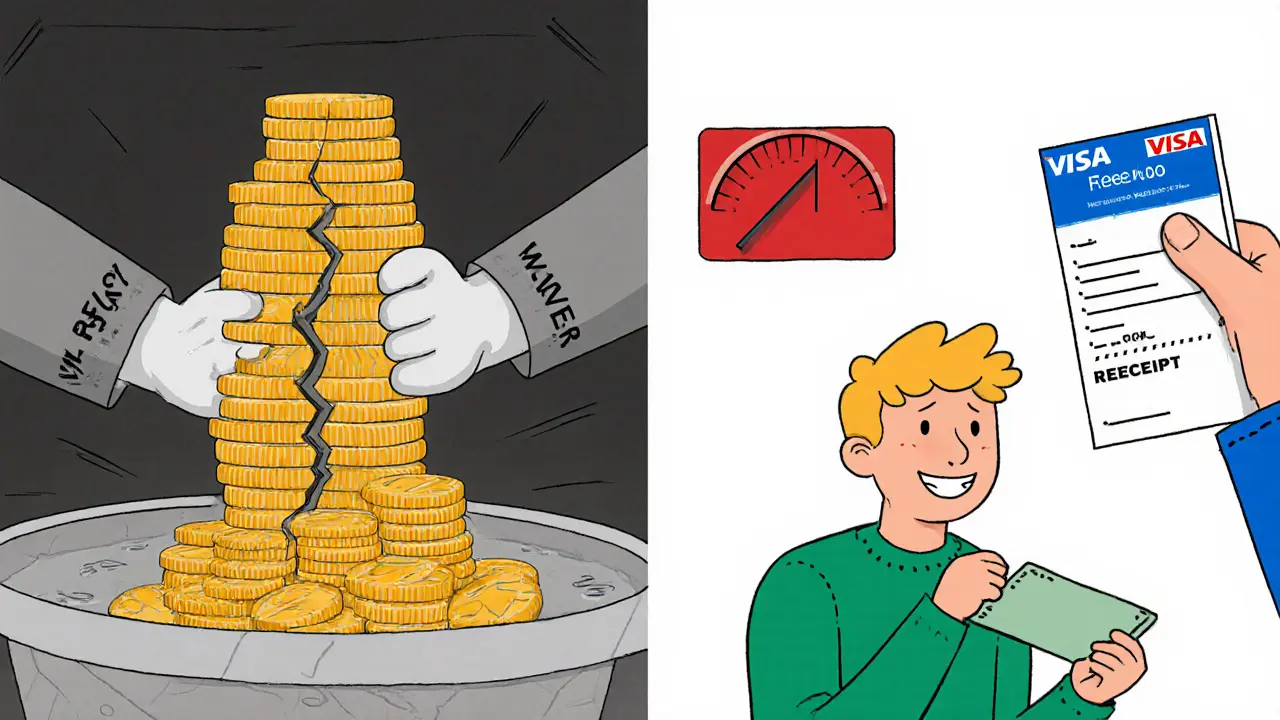 Jul, 7 2025
Jul, 7 2025
WorkQuest Token Earnings Calculator
Estimate Your WQT Earnings
Calculate potential returns from liquidity mining and staking on WorkQuest. Consider gas fees and market conditions for realistic projections.
Earnings Estimate
Key Considerations
Actual results may vary based on market conditions. The WorkQuest platform's liquidity mining APY is up to 12.5%, but this can fluctuate. Gas fees are highly variable on Ethereum.
Risk Reminder
Top 10 wallets hold 68.3% of the circulating supply, creating concentration risk. Token price volatility can significantly impact your returns. See article for detailed risk analysis.
Estimated Earnings
$0.00
Gas Costs
$0.00
Net Return
$0.00
ROI
0.00%
Remember: The WorkQuest platform requires 500 WQT to unlock verified job seeker status, and 10,000 WQT for validator node status. Gas fees can be high on Ethereum (up to 50 gwei recommended during congestion).
Ever wondered what the buzz around WorkQuest Token (WQT) is all about? In short, it’s the native utility token behind WorkQuest - a decentralized job marketplace that tries to fuse freelance hiring with DeFi features.
What is WorkQuest Token?
WorkQuest Token (WQT) is an ERC‑20 token launched on the Ethereum blockchain in 2023 by the WorkQuest DAO. The DAO’s mission, as stated in its public manifesto, is to create a "Loose, Grassroots, Transparent, Open, and Fully global Labor market". In practice, WQT powers every core action on the platform - from posting a job to staking for validator status.
Technical Specs at a Glance
- Standard: ERC‑20 (Ethereum) and bridged to Binance Smart Chain (BSC)
- Contract address:
0x066...095bf(verified on TradingView) - Total supply: 6.00 billion tokens
- Circulating supply (Oct 2025): 5.76 billion
- Governance minimum: holding any amount qualifies for voting, but larger stakes get more weight
- Staking requirement for validator nodes: 10,000 WQT
Core Functions of WQT
The token isn’t just a placeholder; it performs six distinct roles on WorkQuest:
- DAO Governance - token holders vote on protocol upgrades, fee structures, and treasury allocations.
- Collateral for $WUSD - the platform’s stablecoin is over‑collateralized at 150 % using a reserve of volatile crypto assets, with WQT being a key component.
- Referral Rewards - 5 % of platform fees are paid out in WQT to the referrer.
- Liquidity Mining - liquidity providers on Ethereum and BSC pools earn up to 12.5 % APY.
- Payment Token - premium services (background checks, priority listings) cost 0.001 WQT per transaction.
- Proof‑of‑Stake (PoS) for WorkNet - staking enables the newer WorkNet blockchain, which runs at 1,200 TPS after the v2.0 upgrade.
How to Get Started
If you’re new to crypto, the onboarding curve is roughly 15‑20 hours. Here’s the usual flow:
- Create a non‑custodial wallet (MetaMask, Trust Wallet, or Ledger). Most users report a 15‑minute setup.
- Buy ETH or BNB, then swap for WQT on PancakeSwap or a supported DEX.
- Stake the minimum 500 WQT to unlock the “verified job seeker” badge.
- Tip: During Ethereum congestion, bump the gas price to 50 gwei or higher to avoid the 42 % failure rate seen in Q3 2025.
- Use WQT to pay for services, vote on proposals, or provide liquidity.

Tokenomics & Supply Distribution
The token allocation is heavily front‑loaded:
- Team & advisors: 10 %
- Liquidity mining pool: 25 %
- Community & DAO treasury: 30 %
- Public sale & exchange listings: 35 %
Because the top 10 wallets hold 68.3 % of the circulating supply, price manipulation risk is a recurring concern among analysts.
Governance Mechanics
Governance proposals are posted on the DAO’s forum and require a quorum of 4 % of total supply voting yes to pass. Holding more WQT amplifies voting weight linearly. The DAO plans to transfer full control to the community within three years of launch - a timeline outlined in the Q2 2023 governance whitepaper.
Comparative Landscape
WorkQuest sits at the crossroads of traditional freelance platforms and pure‑DeFi job markets. Below is a quick side‑by‑side look.
| Feature | WorkQuest (WQT) | Upwork | Ethlance | DAO of Work |
|---|---|---|---|---|
| Fee Structure | 0.5 % protocol fee | 20 % service fee | 0 % fee | 1‑2 % fee |
| Stablecoin Integration | $WUSD (over‑collateralized) | None | None | None |
| TPS (post‑upgrade) | 1,200 TPS (WorkNet) | ~30 TPS (centralized) | 15 TPS (Ethereum) | ~65 TPS (Polygon) |
| User Base (Oct 2025) | 12,340 | 24 million | ~2,100 | ~5,800 |
| Exchange Listings | 3 DEXs | Global CEXs | 2 DEXs | 4 DEXs |
Risks & Criticisms
Every crypto project has its warning signs, and WQT is no exception.
- Liquidity crunch - daily trading volume hovers around $9.3 K, far below the $1 M benchmark for a healthy market.
- Token concentration - top‑10 wallets control over two‑thirds of supply, making price swings easy.
- Gas fee volatility - Ethereum’s 15 TPS limit still caps throughput; users report up to 42 % transaction failures during peaks.
- Governance‑collateral conflict - analysts at Messari argue that using the same token for voting and as collateral can push the price down when $WUSD depegs.
- Security audit findings - CertiK identified a re‑entrancy bug (CVE‑2025‑38712) that was patched in v2.1.3, but the episode reminded investors to keep an eye on future upgrades.

Real‑World User Experiences
Community sentiment is split. On Reddit, a user named DeFiJobHunter earned $287 in WQT through liquidity mining but spent $142 on gas fees, highlighting the cost-benefit tension. Conversely, a freelancer in Nigeria posted on Twitter that receiving $WUSD for a $150 gig took only 15 minutes, a massive improvement over traditional remittance times.
Still, Trustpilot reviews average 2.1/5 stars, with complaints about withdrawal delays that can stretch beyond 72 hours. The most frequent gripe on CoinGecko’s comment section is “vanishing job listings,” which points to platform‑side data quality challenges.
Future Roadmap
WorkQuest isn’t standing still. Recent milestones include:
- October 5 2025 - WorkNet v2.0 launch, boosting TPS to 1,200.
- October 12 2025 - $WUSD Visa card partnership with Crypto.com, enabling fiat withdrawals.
- Q4 2025 - Integration of Chainlink oracles for automated payroll.
- Q1 2026 - EU market entry pending MiCA compliance.
Analysts differ on the outlook. MEXC’s long‑term model predicts a 238 % price rise by 2050, while Delphi Digital warns of a 70 % chance the project will fold before 2027 unless it hits a $10 M market cap.
Quick Checklist for Prospective Users
- Set up a supported wallet (MetaMask recommended).
- Buy ETH or BNB, swap for WQT on PancakeSwap.
- Check gas price - aim for 50 gwei or higher during busy periods.
- Stake at least 500 WQT to access verified‑seeker features.
- Consider liquidity mining only if you understand APY vs gas costs.
- Participate in DAO votes if you hold a meaningful amount of WQT.
Frequently Asked Questions
What blockchain does WorkQuest Token run on?
WQT is an ERC‑20 token on Ethereum and is also bridged to Binance Smart Chain for lower‑fee transactions.
How can I earn WQT without buying it?
You can earn WQT through the platform’s 5 % referral program, liquidity mining on approved pools, and by completing paid gigs that pay out in the token.
Is $WUSD really stable?
$WUSD is over‑collateralized at 150 % using a reserve that includes WQT and other crypto assets. While it’s designed to stay pegged to USD, sharp downturns in crypto markets have historically pressured its peg.
What are the main risks of holding WQT?
Key risks include low liquidity, high token concentration, volatile gas fees, and the dual‑role conflict between governance and collateral. Security bugs, though patched, also warrant vigilance.
How do I vote on DAO proposals?
Connect your wallet to the WorkQuest DAO portal, lock the amount of WQT you wish to use for voting, and cast your vote on the proposal list. Votes are weighted by the number of tokens you stake.
Whether you’re a freelancer looking for faster cross‑border payments or a crypto enthusiast hunting for the next DeFi‑driven labor market, understanding the mechanics, benefits, and pitfalls of WorkQuest Token is essential before you dive in.
Cynthia Chiang
July 7, 2025 AT 19:11Hey folks, if you're feeling lost in the sea of tokenomics, you're not alone – the WQT ecosystem can be a bit of a maze.
One thing that helps is joining the community chats where people share cheap gas‑saving tips, especially when Ethereum gets crowded.
The token concentration you see isn’t ideal, but remember that the DAO is still young and can evolve with community pressure.
Try staking a modest amount, like 500 WQT, just to unlock the verified‑seeker badge – it’s a low‑risk way to get your feet wet.
And if you ever run into a hiccup, don’t hesitate to ask for help; the best mentors are often the ones who’ve stumbled first.
Stay patient, stay curious, and you’ll definately figure it out together.
Hari Chamlagai
July 8, 2025 AT 20:40WorkQuest Token tries to masquerade as a decentralized solution while hiding under the same old centralization problems that plague traditional platforms.
Its ERC‑20 nature binds it to Ethereum’s notorious congestion, and the gas fee volatility mentioned in the post is just the tip of the iceberg.
The tokenomics are deliberately front‑loaded, giving the team and advisors a comfortable 10 % while allocating a massive 35 % to public sales that can be dumped at any moment.
Concentration in the top ten wallets, accounting for over two‑thirds of supply, creates a full‑blown manipulation engine that any serious investor should fear.
Liquidity is another red flag; a daily volume of roughly $9.3 K is nowhere near the $1 M benchmark for a healthy market, making price discovery practically impossible.
Staking 10,000 WQT for validator status sounds impressive, yet the actual barrier to entry remains prohibitive for the average freelancer.
Using WQT as both governance token and collateral for $WUSD introduces a conflict of interest that can depress the token price whenever the stablecoin depegs.
The re‑entrancy bug CVE‑2025‑38712, although patched, demonstrates that the codebase was not sufficiently audited before launch.
Furthermore, the “over‑collateralized at 150 %” claim rests on volatile crypto assets that can tumble together in a market crash.
The DAO’s quorum requirement of merely 4 % of total supply implies that a small coalition could push through proposals without broad consensus.
While the roadmap boasts a 1,200 TPS WorkNet, no real‑world usage statistics have been published to validate that claim.
Referral rewards of 5 % of fees sound generous, but they merely incentivize token accumulation rather than genuine platform growth.
In practice, freelancers report that gas fees can outweigh earnings, especially on Ethereum where transaction failures exceed 40 % during peaks.
If you compare WorkQuest to Upwork, the fee structure is attractive, yet the underlying token mechanics introduce a layer of financial risk that most workers are not equipped to manage.
In short, the project mixes innovative DeFi features with classic tokenomics pitfalls, and without a substantial organic user base, it is unlikely to survive beyond the next market correction.
Isabelle Graf
July 10, 2025 AT 01:50The token concentration scandal shows that greed overtakes any claim of community‑first values.
Jessica Cadis
July 11, 2025 AT 06:26From a cultural perspective, the promise of a global labor market sounds noble, but the reality is a digital colonization where wealthy token holders dictate terms for workers in developing economies.
The reliance on Ethereum’s expensive infrastructure when cheaper layers exist is baffling.
The governance model feels like a façade for the same power dynamics that have plagued traditional freelancing sites.
If the DAO truly wants inclusivity, it must redistribute stake and lower entry barriers for non‑technical users.
Otherwise, the whole experiment remains a showcase for the privileged.
Jason Zila
July 12, 2025 AT 08:00Looking at the DAO mechanics, any holder can submit proposals, yet the voting weight scales linearly with token amount, which means a whale with a few million WQT can outvote the rest of the community by orders of magnitude.
The minimum quorum of 4 % of total supply is low enough that a coordinated group could pass changes without broad participation.
For a truly decentralized system, quadratic voting or reputation‑based weighting would mitigate this imbalance.
Also, the current staking requirement for validator nodes-10,000 WQT-is a steep hurdle for most freelancers who just want to earn.
Deborah de Beurs
July 13, 2025 AT 12:36Honestly, the DAO’s design feels like a gilded cage, dressed up in fancy jargon while the real power sits snugly in the hands of a few token aristocrats.
It’s as if the architects painted a picture of liberty with watercolors made from gold‑leafed contracts, hoping the community won’t notice the gilded shackles.
When you stomp through the code, you’ll see the same old pattern: promises of fairness, but a backdoor for the elite to siphon rewards.
If the project wants to survive, it should consider a radical redistribution mechanism-perhaps a “mini‑airdrop” that gives every active user a baseline of WQT, breaking the concentration chain.
Otherwise, it’s just another crypto‑washed version of the status‑quo.
Hailey M.
July 14, 2025 AT 17:13Wow, reading about WorkQuest feels like watching a Hollywood blockbuster where the special effects are all gas fees and the plot twists are just token price swings 😅.
The promise of a 1,200 TPS WorkNet is dazzling, but in practice freelancers are still stuck paying more for gas than they earn, which is pure comedy 🤦♀️.
Sure, the $WUSD stablecoin is “over‑collateralized,” but when the crypto market dives, that collateral can evaporate faster than a magician’s rabbit.
And let’s not forget the “referral rewards” that sound sweet until you realize they’re a clever way to keep the token circulating inside a closed loop.
Bottom line: the hype train is leaving the station, and if you’re not on board, you might just watch it disappear into a cloud of burnt‑out gas.
DeAnna Brown
July 15, 2025 AT 21:50Let’s set the record straight: the US crypto scene has always been at the forefront of innovation, and WorkQuest is just the next step in that evolution.
While critics love to harp on gas fees, they forget that American developers are building layer‑2 solutions that will slash costs dramatically within months.
Our nation’s talent pool can handle the technical challenges, turning what some see as a flaw into a feature of a resilient, adaptable ecosystem.
So before dismissing the project as a “hype train,” remember that American ingenuity has turned every skeptic’s doubt into a new opportunity.
Nick O'Connor
July 16, 2025 AT 23:40In summary, the WorkQuest Token presents a blend of innovative DeFi concepts, such as staking, liquidity mining, and DAO governance, yet it is hampered by significant risks, including token concentration, low liquidity, and volatile gas fees, which together create a precarious environment for users, especially those new to the space, who must navigate complex technical requirements and potential security vulnerabilities, meaning that thorough due diligence, careful risk assessment, and a clear understanding of both the platform’s strengths and its shortcomings are essential before committing any capital.